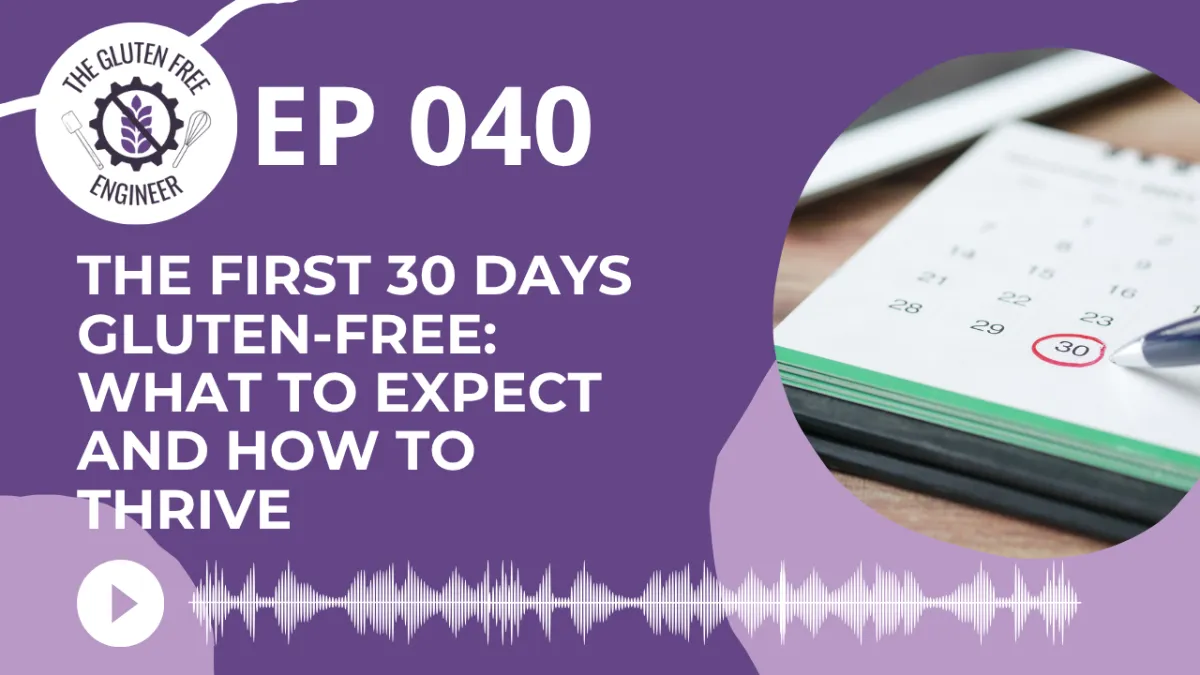
#40: The First 30 Days Gluten-Free: What to Expect and How to Thrive
The first 30 days gluten-free can feel overwhelming — you’re cleaning out the pantry, reading labels like a detective, and maybe even wondering if you’ll ever feel normal again. But here’s the good news: those first weeks can also be a time of big wins if you know what to expect.
In today’s episode, I’ll share the changes you might notice in your body, the challenges that trip people up, and practical tips to not just survive — but thrive — in your first month gluten-free. And stick with me until the end, because I’ll share the one thing that made the biggest difference for me in those early days.
Let's Recap: Your First 30 Days Gluten-Free - What to Expect and How to Thrive
Embarking on a gluten-free journey can feel overwhelming, especially during those first crucial 30 days. Whether you've been diagnosed with celiac disease or are eliminating gluten for other health reasons, knowing what to expect can make the transition significantly smoother.
As someone who has navigated this path personally, I want to share insights about what happens in your body and mind during each phase of this transition—and how to make those early weeks a little easier.
Week 1: Detox and Overwhelm
The first week of going gluten-free is often the most challenging. This period is what I call the “detox and overwhelm phase.”
Many people experience physical withdrawal symptoms such as headaches, fatigue, and mood swings, similar to what people report during the “keto flu.” This happens because your gut microbiome is changing—the bacteria that thrived on gluten are being starved, and they’re not happy about it!
At the same time, you’re likely feeling mentally overwhelmed. Cleaning out your pantry, learning to read labels like a detective, and figuring out what to eat without your usual staples can be exhausting.
Don’t overlook the emotional impact either. It’s normal to grieve favorite foods or feel anxious about cross-contamination, especially if you have celiac disease. During this week, having a support system—friends, family, or an online community—can make all the difference.
Week 2: Learning Mode
By week two, things start to click. You’ll likely enter “learning mode.”
Your label-reading skills improve, and you get better at spotting hidden sources of gluten in sauces, dressings, and seasonings. This is also the time to embrace naturally gluten-free foods—fresh fruits, vegetables, unprocessed meats, and whole foods with minimal ingredients.
Establishing a few easy go-to meals can help minimize decision fatigue while your brain adjusts. Maybe it’s eggs and certified gluten-free toast for breakfast or a simple protein-and-vegetable combo for lunch.
Discovering trustworthy brands like Tessemae’s and Primal Kitchen, which clearly label gluten-free products, can be small wins that make meal prep far less stressful.
Week 3: Feeling the Difference
By the third week, you’ll likely begin to feel the rewards of your efforts. Many people report less bloating, better digestion, more energy, and improved mental clarity.
I remember feeling like the world suddenly came into high definition—everything looked clearer, and my thinking was sharper.
This is also when your confidence grows. You’ll get more comfortable dining out, reading menus, and navigating grocery stores. Still, keep in mind that mistakes happen, even to seasoned gluten-free eaters. Instead of beating yourself up, treat each slip-up as a learning experience.
Week 4: Settling Into Your New Normal
By week four, you’ll start to feel truly settled. You’ve likely found favorite products, meals, and snacks that meet your needs and tastes.
The physical improvements are now undeniable, providing powerful motivation to continue. Most people find that the thought of feeling sick from gluten just isn’t worth it anymore.
At this stage, you’re not just surviving gluten-free—you’re thriving gluten-free. You’re focusing less on what you’ve lost and more on what you’ve gained: new foods, healthier habits, and renewed energy.
Tips for a Smooth Transition
Throughout these 30 days, a few key strategies can make the process much smoother:
Plan simple meals to avoid feeling overwhelmed.
Keep safe snacks with you to prevent getting stuck hungry with no gluten-free options.
Join support groups or online communities to connect with others on the same journey.
Give yourself grace. The learning curve is steep, but perfection isn’t the goal—progress is.
One of the most helpful things I did early on was keeping a list of safe go-to meals and snacks. This simple tool removed the stress of decision-making and gave me a reliable backup when energy and willpower were low.
Final Thoughts
Going gluten-free is more than eliminating a protein from your diet—it’s about building a healthier, more mindful relationship with food and your body.
The first 30 days may be challenging, but with preparation, patience, and self-compassion, you’ll come out stronger, healthier, and ready to thrive in your new gluten-free lifestyle.
Mentioned Resources
EP 13: https://theglutenfreeengineer.com/post/hidden-gluten-where-contamination-lurks-in-your-kitchen
EP 15: https://theglutenfreeengineer.com/post/the-emotional-side-of-going-gluten-free
